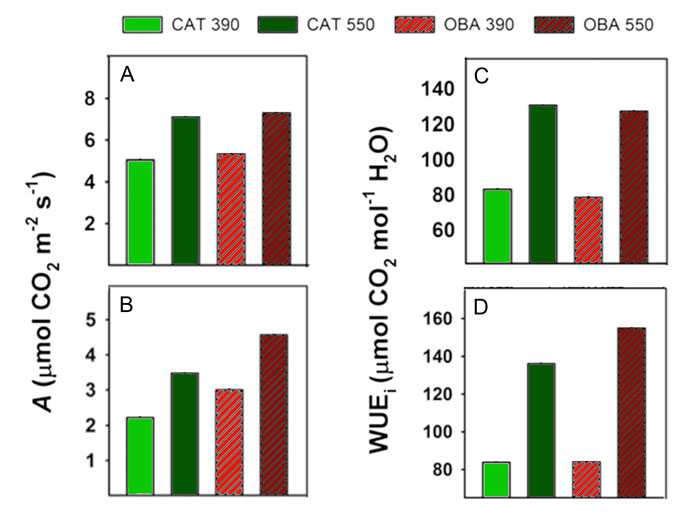PICTURE: Figure 1. Effect of ambient (390 ppm) and elevated (550 ppm) CO2 concentration on two coffee cultivars, Catuaí (CAT) and Obatã (OBA), growing in a FACE construct: (Panel A, top left) net CO2 assimilation rate (A) during the growing season, (Panel B, bottom left) net CO2 assimilation rate during the winter, (Panel C, top right) water use efficiency (WUE), defined as internal-to-ambient CO2 concentration ratio (Ci/Ca, during the growing season, (Panel D, bottom right) water use efficiency during the winter. Adapted from Ghini et al. (2015).
By CRAIG D. IDSO+
In the global market, coffee is one of the most heavily traded commodities, where more than 80 million people are involved in its cultivation, processing, transportation and marketing (Santos et al., 2015).
Cultivated in over 70 countries, retail sales are estimated at $90 billion USD. Given such agricultural prominence, it is therefore somewhat surprising, in the words of Ghini et al. (2015) that “there is virtually no information about the effects of rising atmospheric CO2 on field-grown coffee trees.”
Rather, there exists only a few modeling studies that estimate a future in which coffee plants suffer (1) severe yield losses (Gay et al., 2006), (2) a reduction in suitable growing area (Zullo et al., 2011), (3) extinction of certain wild populations (Davis et al., 2012) and (4) increased damage from herbivore, pathogen and pest attacks (Ghini et al., 2011; 2012; Jaramillo et al., 2011; Kutywayo et al., 2013), all in consequence of predicted changes in climate due to rising atmospheric CO2.
In an effort to assess such speculative model-based predictions, the ten-member scientific team of Ghini et al. set out to conduct an experiment to observationally determine the response of two coffee cultivars to elevated levels of atmospheric CO2 in the first Free-air CO2 Enrichment (FACE) facility in Latin America.
Small specimens (3-4 pairs of leaves) of two coffee cultivars, Catuaí and Obatã, were sown in the field under ambient (~390 ppm) and enriched (~550 ppm) CO2 conditions in August of 2011 and allowed to grow under normal cultural growing conditions without supplemental irrigation for a period of 2 years.
No significant effect of CO2 was observed on the growth parameters during the first year. However, during the growing season of year 2, net photosynthesis increased by 40% (see Figure 1a) and plant water use efficiency by approximately 60% (Figure 1b), regardless of cultivar. During the winter, when growth was limited, daily mean net photosynthesis “averaged 56% higher in the plants treated with CO2 than in their untreated counterparts” (Figure 1c).
Water use efficiency in winter was also significantly higher (62% for Catuaí and 85% for Obatã, see Figure 1d). Such beneficial impacts resulted in significant CO2-induced increases in plant height (7.4% for Catuaí and 9.7% for Obatã), stem diameter (9.5% for Catuaí and 13.4% for Obatã) and harvestable yield (14.6% for Catuaí and 12.0% for Obatã) over the course of year 2. Furthermore, Ghini et al. report that the increased crop yield “was associated with an increased number of fruits per branch, with no differences in fruit weight.”
Some have hypothesized that increasing plant matter associated with elevated CO2 would contain less protein, but with respect to leaf nitrogen content (a marker for protein content), the authors report it was “within an expected range for coffee” for both cultivars at both CO2 concentrations, “implying that no apparent N deficiency was observed in this study.”
Ghini et al. were also able to examine the combined impact of elevated CO2 and plant damage from pests and disease. Here, they found that “under elevated CO2 reduced incidence of leaf miners (Leucoptera coffeela) occurred on both cultivars during periods of high infestation.” In addition, they report there was no significant effect of CO2 treatment on disease incidence of rust (Hemileia vastatrix) and Cercospora leaf spot (Cercospora coffeicola); and fungal communities associated with mycotoxins was not affected either.
All in all, it is quite clear that this observational assessment of the impacts of rising atmospheric CO2 concentrations on coffee plants is quite different from that derived from model-based analyses.
And because observations always trump projections, those who cultivate, process, transport, market, and drink coffee now have a much more optimistic future to look forward to, a world in which coffee plants will benefit from this ever-benevolent aerial fertilizer!


















